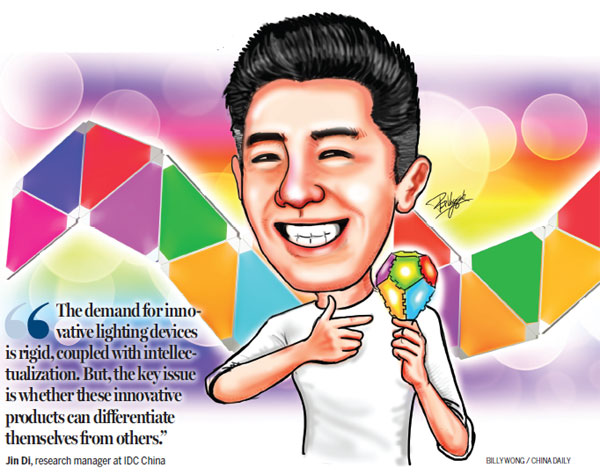Saving energy with a multi-tinged switch
Updated: 2017-01-05 07:37
By Chai Hua in Shenzhen(HK Edition)
|
|||||||

Editor's note: The global residential smart-lighting market is projected to reach new highs within three years. Along with it has come a string of innovative lighting devices that promise to revolutionize the industry, including one from a Shenzhen startup with a colorful contribution.
Smart home design and decoration has been given an extra touch of color - a Shenzhen startup has come up with an innovative product via customized light.
The palette of this new art is a set of triangular LED light panels, providing up to 16 million colors and numerous shapes when assembled together like Lego.
The product, called Aurora, is the brainchild of the founders of Nanoleaf Energy Technology Shenzhen Ltd - a lighting technology enterprise launched some five years ago by three graduates of the University of Toronto. The company has offices in both Canada and Hong Kong.
The smart-lighting market, including residential, commercial, outdoor and street lighting, had been projected to hit $6 billion globally in 2015 and double by 2020, according to a report by research firm IHS Markit.
The market, which has grown from $1 billion in 2015 and tipped to exceed $4 billion by 2020, is seen as one of the industry's biggest achievements.
Paul Bremner, market analyst for lighting and LEDs at IHS Markit, said: "One of the key driving factors for the residential market is the associated growth of smart-home systems which allow consumers to control various devices around their homes through a combination of their smartphones and even voice commands."

The systems he referred to include Apple's HomeKit, Google's Nest, Samsung's SmartThings and Amazon's Alexa.
In fact, Nanoleaf's first innovative project - an energy-efficient LED origami lightbulb which won investment from Hong Kong billionaire Li Ka-shing - is one of the world's three smart-lighting product produced in association with Homekit, together with Philips Hue White and Color Ambiance Starter Kit.
Christian Yan, chief operating officer of Nanoleaf, said they discovered that players in the smart-lighting sector have all been working on the same type of light bulb, so making it different by giving it a triangular look is one of the new product's most innovative factors.
"The triangular shape is modular and flexible, so users can make their own design, while light from three corners allows a good mix of colors," says the young entrepreneur, who's in his 30's with an engineering background.
Another unique feature of Aurora is its color. Like the Philips Hue bulb, Aurora promises color changing by control of the smart phone, voice and a switch. But, instead of controlling one source of light, it supports the programming of a wall of lighting.
Powered by a single power supply, the Aurora device can link up to 30 panels with WiFi. Users can also program their colors and the sequence, meaning the art of light can keep changing according to a pattern.
The New York-based Museum of Modern Art (MoMa) described it as a "wall art made of light" after it was launched there for the first time worldwide in September last year. Within three months, the product had raked in $1 million in sales in the United States, according to Yan.
The inspiration comes from aurora borealis - the company Nanoleaf Chief Executive Officer Gimmy Chu saw while on a flight in Canada - and they were determined to bring the art of nature to human's living space.
Yan said that, for instance, users can "paint" sunrise and if they saying "Good Morning" to computer program Siri the next day, Aurora will automatically change to the sunrise light.
Instead of resorting to a crowdfunding website as their first distribution channel, Nanoleaf picked a museum for the product's global launch, as well as a high-end interior designing brand partner for the Chinese mainland market.
Yan explained that their strategy is "to start from the top". Working with MoMA shows that their product is of high quality and rich design element, he says, and it's this quality that has caught the attention and interest of other retailers.
Nanoleaf will explore other shapes of light and innovative accessories in future, such as easier switch and wireless remote control.
Smart-lighting industry experts have warned that competition will be very intense. "The demand for innovative lighting devices is rigid, coupled with intellectualization," says Jin Di, research manager at IDC China. "But, the key issue is whether these innovative products can differentiate themselves from others."
It's either super energy saving or something that can solve people's real problems in different living scenarios automatically, she adds.
grace@chinadailyhk.com
(HK Edition 01/05/2017 page9)